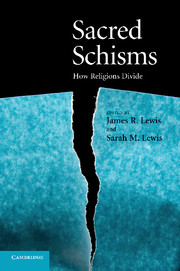Book contents
- Frontmatter
- Contents
- List of figures
- Notes on contributors
- Acknowledgments
- Introduction
- PART I THEORETICAL OVERVIEW
- PART II SURVEY OF SCHISMS IN SELECTED TRADITIONS
- PART III CHRISTIAN TRADITIONS
- 5 Finishing the Mystery: the Watch Tower and “the 1917 schism”
- 6 Challenges to charismatic authority in the Unificationist Movement
- 7 Persecution and schismogenesis: how a penitential crisis over mass apostasy facilitated the triumph of Catholic Christianity in the Roman Empire
- PART IV WESTERN ESOTERIC TRADITIONS
- PART V NON-WESTERN/POSTCOLONIAL TRADITIONS
- Index
- References
6 - Challenges to charismatic authority in the Unificationist Movement
Published online by Cambridge University Press: 24 October 2009
- Frontmatter
- Contents
- List of figures
- Notes on contributors
- Acknowledgments
- Introduction
- PART I THEORETICAL OVERVIEW
- PART II SURVEY OF SCHISMS IN SELECTED TRADITIONS
- PART III CHRISTIAN TRADITIONS
- 5 Finishing the Mystery: the Watch Tower and “the 1917 schism”
- 6 Challenges to charismatic authority in the Unificationist Movement
- 7 Persecution and schismogenesis: how a penitential crisis over mass apostasy facilitated the triumph of Catholic Christianity in the Roman Empire
- PART IV WESTERN ESOTERIC TRADITIONS
- PART V NON-WESTERN/POSTCOLONIAL TRADITIONS
- Index
- References
Summary
One important issue in understanding the emergence and development of new religious movements (NRMs) is the durability and survivability of movement leadership. There is little question that during NRMs' first generation the charismatic authority of the founder/leader is the primary source of movement legitimation and cohesiveness. At the same time, NRM founders also oversee the movement's organizational development. While types of leadership may be divided into the traditional, charismatic, and rational legal ideal types that Weber (1964) has constructed, actual movement leadership is likely to combine these types. In order to understand both the strengths and vulnerabilities of NRM leadership, therefore, both charismatic and organizational leadership must be considered. Further, as movements develop they become more complex entities. NRMs initially tend to form around a charismatic leader based on that individual's revelatory or mystical experience. At this juncture movements mirror the traditional sociological conception of a cult, a loosely organized group with a charismatic leader. As movements develop, they are likely to consist of three major components: the inner circle, which is composed of the founder/leader and a small number of confidants; a set of administrative, economic, and mission-oriented organizations, which increasingly assume a rational-legal, bureaucratic form; and a grassroots membership base, which during the first generation consists exclusively of movement converts (Bromley and Bobbitt 2006; Zald and Berger 1978). In this chapter we argue that each of these three movement segments constitutes a power base, and challenges to charismatic authority may emanate from one or more of these sources.
- Type
- Chapter
- Information
- Sacred SchismsHow Religions Divide, pp. 129 - 146Publisher: Cambridge University PressPrint publication year: 2009
References
- 1
- Cited by



